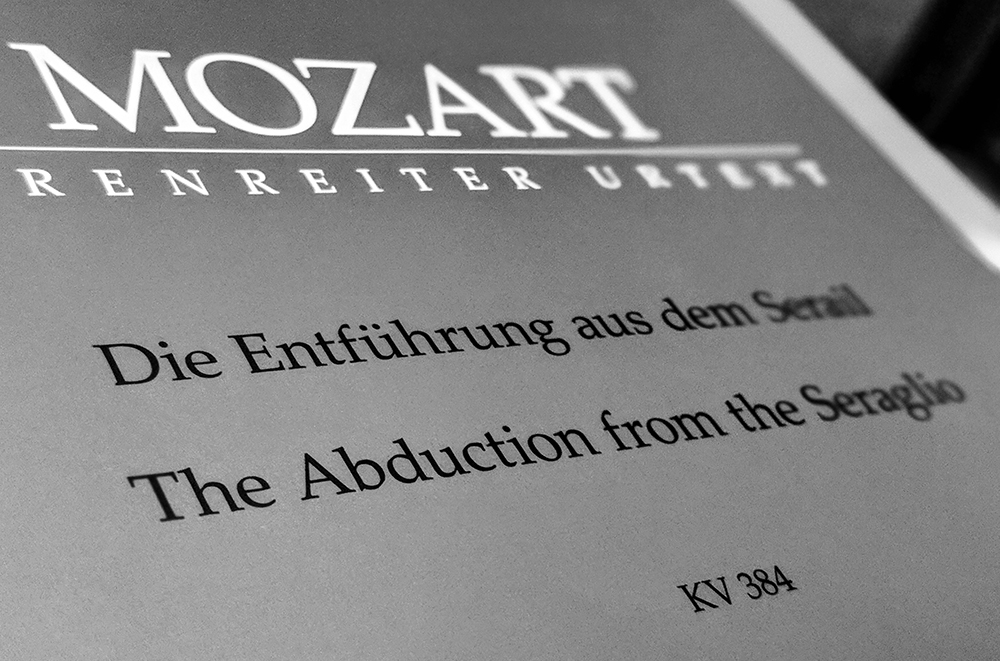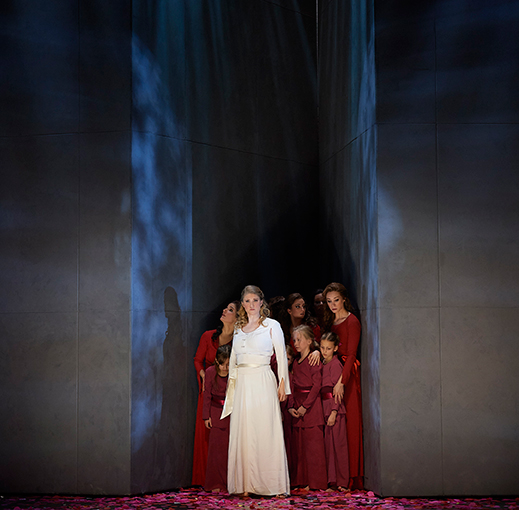-
Liner Notes: 5 Excerpts from The Abduction from the Seraglio
By Stéphane MayerPosted in The Abduction from the Seraglio
At the age of 25, young W.A. Mozart, disgruntled with his employment under the Archbishop Colloredo, was eager to leave his native provincial town of Salzburg and pursue loftier projects in the imperial city of Vienna. Once there, he quickly became acquainted with important figures in the city’s musical scene and within a year secured a commission for a new opera. The Abduction from the Seraglio premiered at the Burgtheater to great success on July 16, 1782. This landmark work secured Mozart’s reputation as the finest composer of his time. The score is brimming with musical innovation which still astounds to this day. In the hopes of trying to shed some light on the devices and techniques Mozart used to construct this musical drama, I decided to set out and describe five of my favourite moments from the opera.
1) Word painting in Belmonte’s “O wie ängstlich”
Word painting is a common musical device where evocative musical figures are used to underpin specific sections of a text. Think of the “spinning wheel” motion of the accompaniment in Schubert’s Gretchen am Spinnrade or the undulating “water” music in Elgar’s Sea Pictures. Mozart also makes ample use of this device and no instance is more evident in The Abduction from the Seraglio than in Belmonte’s Act I aria “O wie ängstlich.”
Here our hero is reeling at the thought of seeing his beloved Konstanze once more after having been separated for over two years. The orchestra reflects his thoughts by mimicking the anxious beating of Belmonte’s heart with quick staccato octaves, the swelling of his breast with a long crescendo line full of repeated notes, and finally a flute imitates the imagined whispers of his beloved."Belmonte’s heart"
"...swelling of his breast & whispers of his beloved."
By so effectively using word painting in the orchestra, Mozart is able to distill the thoughts of Belmonte and give life to them through musical means.
Full Aria:
2) A quartet of soloists in Konstanze’s “Martern aller Arten”
Halfway through the opera, the character of Konstanze is faced with an impossible choice, submit herself to the whims of the Bassa Selim or else face death. Konstanze’s resolve is strong and she answers the Bassa by singing this tour de force piece. Her lines in this aria are some of the most challenging in the entire soprano repertoire, showcasing dizzying coloratura passages, incredibly long sustained notes, huge melodic leaps and an extensive overall range (low B4 to high D6). However, what is most astounding about this aria is that Mozart also incorporates a quartet of solo instruments (violin, cello, flute and oboe) from within the full orchestra whose lines are equally as difficult as those of Konstanze’s. The resulting effect is an incredible display of virtuosity from all parties involved. The elaborate counterpoint and interplay of all of the independent instruments perfectly encapsulate the complexity of Konstanze’s character, and at once both reflects her inner turmoil and her outward resolve.
3) Blonde’s feisty lines in the quartet “Ach, Belmonte”
This famous quartet from the end of Act II is an important precursor to the elaborate finales of Mozart’s more mature operas like The Marriage of Figaro and Così fan tutte. The musical structure is split up into various independent sections and provides a quickly changing backdrop to the unfolding drama.
Here the lovers are finally reunited after years of separation. Their joy is cut short, however, when the men begin questioning whether the women remained faithful during their captivity in the seraglio. After Konstanze and Blonde make their indignation clearly known, the two men recoil and beg for forgiveness.
In this section, we see Mozart’s true genius shine through as an ensemble writer. Two conversations are happening simultaneously: while Konstanze and Belmonte (the “noble” characters) argue in what seems like a very dignified way—employing long legato lines, a limited vocal range and “waiting” for the other character to finish—Blonde and Pedrillo (the “lower class” characters) are conducting their dispute in a much different fashion. Blonde interrupts Pedrillo with an agitated vocal line set in a different time signature from that of the orchestra (12/8 versus 4/4). Her line is much more disjointed, often including sudden and dramatic shifts in vocal range and it has a “folk-like” lilt to it, further reinforcing her lower class status. The resulting effect is that we see Blonde as a fiery and hot-tempered character, while Konstanze remains more stoic and in control of her emotions. Every time I listen to this scene unfold, I am reminded of a similar passage in Puccini’s La Bohème (Act III quartet) where Musetta and Marcello are fighting between themselves while simultaneously Mimì and Rodolfo are lamenting their love for each other. I wonder if Puccini might have secretly been a Mozart fanatic and that this scene was his homage to the great master. This is purely speculative of course, yet still fun to imagine.
4) A “fade-out” in a classic serenade, Pedrillo’s “Romance”
Mozart loves his serenades (“Deh vieni alla finestra” from Don Giovanni and “Deh vieni non tardar” from The Marriage of Figaro being the most notable examples) and he tends to always orchestrate them in very similar fashion by relying heavily on pizzicato strings to imitate the sound of a strummed guitar, mandolin, or lute.
In this “Romance” sung by Pedrillo in Act III, Mozart does the very same. Here Pedrillo calls on the ladies in a discreet fashion by singing a little nighttime serenade. The effect is mesmerizing, the orchestra is paired down dramatically and all you hear is the voice soar on top of a very simple plucked string accompaniment.
The orchestral forces are so sparse in this little aria that the singers are even granted the luxury of speaking a few lines of dialogue during the interludes between the verses, something that could not be done if the orchestra was playing out fully. Mozart always understood the power of simplicity and balance—after so much drama and thick orchestration, this little song comes as a welcome respite for the ears of the listener. Another astounding feature of this aria is that it doesn’t end, it simply fades out! It's a little moment of magic tucked away within a monumental work.
5) Osmin's insane range, “O, wie will ich triumphieren”Like I said before, Mozart wrote The Abduction from the Seraglio after moving to Vienna. Here in the big city, the quality of singers at his disposal must have been much greater than those in his native Salzburg. Mozart was therefore able to write in a much more virtuosic way than he had been able to before.
In the case of Osmin, we have one of the most demanding bass roles in the repertoire. The range tops of at an F and goes all the way down to a low D! This insane lower extension of range is like a mirror version of the Queen of the Night. In his final aria, Osmin has an incredible passage where the singer has to sing agile coloratura passages at a very rapid tempo (something that is very rare for bass voices which tend to enjoy “luxuriating” a bit more than other voice types) before descending to a low D, which is then sustained for eight whole bars. On top of that, the orchestra is still playing so the singers must have incredible projection capabilities way down in the depths of his range. It’s a difficult aria, but when a singer is up to meet the challenge it creates a memorable experience for those lucky enough to be sitting in the audience.
Photo credit: Jane Archibald (centre) in The Abduction from the Seraglio (COC 2018), photo: Michael Cooper.
Music credit: The Abduction from the Seraglio. John Eliot Gardiner, conductor, with the English Baroque Soloists, 1995. Archiv Production.
